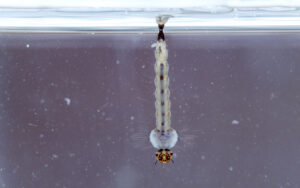
Good bugs are no quick fix
By Denis Crawford
Biological control may not be an instant pest solution, but it is a pest control option well worth pursuing.
Large parts of eastern Australia have just been through a very wet spring and early summer. That period of warm wet weather meant a boom time for mosquitoes, they were everywhere in huge numbers. As I write this article, it is almost mid-summer and many people living in some of those areas have noticed that the mosquitoes have largely disappeared. The insects dominating the skies now are dragonflies and, to a lesser extent, damselflies.
Dragonflies and damselflies are predators of both larval and adult mosquitoes. The larvae of mosquitoes are preyed on by dragonfly and damselfly larvae underwater. Dragonfly and damselfly larvae are ferocious predators and have extendable mouthparts not dissimilar to those of the terrifying Xenomorph from the movie ‘Aliens’. Adult mosquitoes are preyed on by adult dragonflies and damselflies.
However, dragonflies and damselflies weren’t solely responsible for the containment of last year’s bumper mosquito population. Mosquitoes are food for many other animals. For example, mosquito larvae are a major food source for native fish and waterbird species. Adult mosquitoes are food for insectivorous birds as well as insectivorous bats. Another factor is drying weather, shrinking pools means the mosquito population also shrinks. All this takes time though. The theme of this Pest Files is that biological control of any insect or mite pest requires patience.

(Supplied by Denis Crawford of Graphic Science)
I’ve said many times in these pages that for most insects you can think of, there is another insect that wants to feed on it or breed in it. This equation applies in nature as well as in horticultural and agricultural crops. Biological control may not be a quick fix but given time it can be mighty effective.
Biological control goes back a long way, in fact it precedes the modern pesticide-focused era of horticultural and agricultural pest control. In a recent Pest Files, I mentioned the vedalia beetle (Rodolia cardinalis), an Australian ladybird beetle, which was introduced into the USA in 1888. The beetle was imported to control cottony cushion scale (Icerya purchasi), also an Australian native which had devastated the Californian citrus industry. About 18 months later the pest was completely controlled wherever the beetle had been introduced. It is not stretching the truth to say that Rodolia cardinalis saved the Californian citrus industry.
Rodolia cardinalis was selected because field research in Australia had shown the beetle was very effective at controlling cottony cushion scale. The beetle has since been exported to over 30 other countries with similar results. Rodolia cardinalis is an example of classical biological control where an exotic biological control agent is introduced to control an exotic pest. An Australian example might be the parasitic wasps that were introduced here to control cabbage white butterfly (Pieris rapae) which originated from Europe.

Classical biological control requires cooperation between governments and biosecurity agencies as well as considerable scientific research. A simpler way to introduce beneficial insects or mites is to augment existing predators and parasites with releases of commercially available beneficials. An example might be the release of predatory mites (e.g. Phytoseiulus persimilis) to control an outbreak of two-spotted mites (Tetranychus urticae) in a glasshouse. The introduced predators will initially make little difference to the two-spotted mite population because the predators need to build up their population first. Phytoseiulus persimilis (aka Persimilis) mites breed at twice the rate of two-spotted mites, and once predator numbers are significant the pest mite will be brought under control.
An even simpler (and cheaper) form of biological control is to conserve and encourage naturally occurring predators and parasites. It doesn’t happen overnight though. You need to be able to identify the beneficial insects that are in your crops, gardens or nurseries. To encourage naturally occurring parasites in particular, it is a good idea to provide pollen and nectar sources. Most importantly, insecticide applications must be minimised, and if insecticides are required, selective insecticides should be used where available.
We know what happens when broad-spectrum insecticides are used indiscriminately. It has been demonstrated many times. A broad-spectrum insecticide not only kills the pest that you are targeting but also the natural enemies of that pest and the natural enemies of other pests. That is why after spraying one pest you may get an outbreak of a different pest. When a more targeted and less toxic alternative is used, there is greater survival of natural enemies, and the likelihood of secondary pest outbreaks is reduced to virtually nil.
I used the term ‘quick fix’ in the title quite deliberately. It is the pursuit of ‘quick fix’ solutions to pest problems that has helped create the situation we now find ourselves in. Some serious insect and mite pests are resistant to some, if not all, of the pesticides registered against them. Insect biodiversity is threatened in many parts of the world, and pesticides are one of the causal factors. Global warming is likely to make things even worse.
The solution is to only use pesticides as a last resort rather than as a first resort. There are lots of alternative control methods such as growing resistant varieties, physical control methods such as finding egg masses and pruning them off where practical, and preserving existing populations of natural enemies. Sounds like integrated pest management (IPM) to me.
Main photo: Persimilis mites (orange) breed faster than two-spotted mites (Supplied by Denis Crawford of Graphic Science)
